INTRODUCTION
Readily observable features in oyster shells (Ostrea edulis) from archaeological excavations can provide important evidence of where the oysters came from and the way they were exploited by man.
This article gives a brief overview of the methods and preliminary results of investigations that are being made into oysters from excavations of archaeological sites in Britain using observations of their macroscopic characteristics. It is based on a series of published and unpublished reports made to archaeological organisations, and on the doctoral thesis: A study of the variation in oyster shells from archaeological sites and a discussion of oyster exploitation (Winder 1993).
BACKGROUND TO THE RESEARCH
Awareness of this potential research opportunity was raised in the 1970s when a surge of construction development and its associated archaeological investigations uncovered large quantities of marine mollusc shells. An example of this was the excavation of Saxon Hamwic in Southampton where vast numbers of marine shells were recovered, mainly oyster, from domestic rubbish pits. The archaeologists had hundreds of large museum boxes full of mud-caked shells in store and wanted to know what to do with them. Had these shells, they wanted to know, any potential for site interpretation? If so, could they be used to indicate how important marine molluscs were in the diet of the community? Where did the shellfish come from? Was it possible to establish the locations being fished in order to understand how far afield people were going for food and to suggest trade links and routes? How intensively were the shellfish beds being exploited – how much effort and organisation was invested in the activity?
Another aspect which intrigued archaeologists was whether some degree of oyster cultivation had been taking place. Were the oysters fished from natural (wild) beds or were they farmed, cultivated and subjected to more commercially orientated activities? It has always been assumed by historians that the Romans introduced oyster cultivation to Britain but could this be substantiated from the archaeological record?
The problem for the archaeomalacologist is to discover what actually survives in the oyster shells that can possibly help to answer the questions posed by the archaeologists about the way people have exploited oysters in the past. Much of what is already known about the oyster and man relationship can be found in the general literature, particularly accounts from the 19th and early 20th century discussing eating, fishing and farming oysters. Despite some serious gaps in the periods covered, and not a few misunderstandings, this older literature contains some very useful information - including a quotation from the Roman poet Lucilius who said:
When I but see the oyster’s shell,
I look and recognise the river, marsh or mud,
Where it was raised.
It is clear from allusions in the literature that, in fresh oyster shells at least, it is possible to observe variations that could be attributed to the place of origin. This idea was developed by Alfred Bell (1921) where he meticulously described variations on British oyster shell shape, ascribing sub- species and variety names to specimens from different locations. Unfortunately, it seems likely that his descriptions may have been based on just a single specimen in some cases.
METHODS
Many of the distinguishing features found in the shells of fresh or live oysters may not survive burial conditions over hundreds of years. Most soft parts of the mollusc itself, or the organisms attached to it, are likely to be absent. Breakage, wear and erosion will have affected harder parts, smoothing the sculpturing or ornamentation and damaging adhering epibiont structures. Whilst many excavated shells are worn and relatively featureless, some can remain surprisingly fresh in their appearance and even retain pigmentation and fragments of ligament and periostracum. Figure 1 shows the similarity between an oyster washed up on the beach at Oxwich Bay, Gower in 2005 and a 12th century shell recovered from an extensive midden on the edge of Poole Harbour in Dorset.
The one thing that was abundantly clear from the examination of that first batch of oyster shells from Saxon Southampton (Winder 1980; Winder 1997) was that the size and shape varied considerably within the samples. And once the shells had been carefully washed, other features could be seen such as the remains of encrusting epibiont organisms like barnacles and Bryozoa, and damage caused by burrowing worms and sponges. The shells could be adhered together in clumps. Miscellaneous debris like pebbles or other marine mollusc shells was frequently attached. Man- made marks were noted such as v-shaped notches on the shell margin caused by opening the oyster and cut marks on the smooth inner surface where the meat had been scraped off. A collage of some of these epibionts on oyster shells can be seen in Figure 2.
A standard method has been devised for recording both the measurable and objective features as well as the subjective and descriptive characters of each oyster shell. Up to 25 features are recorded. The information can be collated and expressed as a mean frequency of occurrence of each characteristic in the whole sample. These frequencies give each sample a unique description. The samples can then be compared on an intrasite or intersite basis, between feature types, different areas of site, and different periods of occupation.
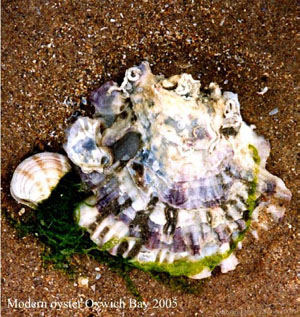
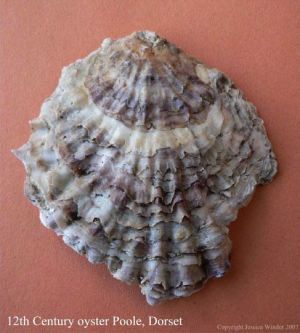
figure 1: Two well-preserved Ostrea edulis L. left valves showing colour banding left: Modern 21st century oyster shell washed up on the beach at Oxwich Bay, Gower right: Early medieval 12th century oyster shell Poole, Dorset.
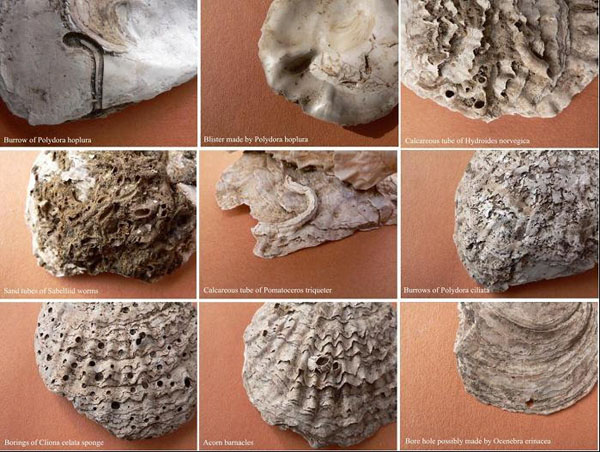
figure 2: Examples of surviving evidence of epibiont organisms in archaeological oyster shells.
CAVEATS TO ANALYSES OF THE ARCHAEOLOGICAL DATA
There are many challenges to working with archaeological oyster shells. There are possible biases to the material that would affect the analysis and interpretation of the data. For example, how representative are the shells from an individual site of the original incoming samples to that site – both in quality and quantity? Moorgate and Coleman Street excavations in London (Winder 1987) of 11-12th century domestic rubbish pits uncovered strikingly different shells in different pits. One contained poor quality oysters of very small and very large size, while the other had all the better quality shells of the optimal mid size range. It is easy to see how erroneous conclusions could have been drawn if the specimens from only one pit had been selected for analysis.
Has there been an excavation bias with only the larger or intact shells being retained? How much reliance can be placed on comparisons of archaeological oyster shells with samples of modern material from known locations?
Finally, the taphonomic history of the shells, soil conditions and disposal methods will affect the chemical and mechanical wear on the shells. There is randomness to shell survival and recovery as well as to the process of shells being made available for study. All of these factors have to be considered and they place restraints on the interpretations based on the shells. Additionally, there can never be enough samples. With this awareness, the following analysis of the data was carried out.
A FEW RESULTS
Some results of the analyses of the two main contributors to variability in the shells of O. edulis L. are presented here. These relate to size and evidence of infestation and encrustation by epibionts.
Size differences
The size of oyster shells recovered from ancient sites results from a combination of factors: natural environment, genetics and human influence. Examining size can potentially help to distinguish, for example, between oysters originating from different localities or subject to varying fishing practices. Measurements of approximately 20,000 oyster shells were used initially and comparisons between the samples made by parametric and non-parametric tests for various categories of sample. These categories included samples from different geographical regions, inland and coastal sites, urban and rural sites, and various historical periods.
Comparisons of size for broadly defined historical periods reveal interesting variations in mean sizes between the Roman, Saxon, Medieval, Post-medieval and Modern oyster shells. This appears to indicate statistically significant temporal differences in the average size of oyster shells. Roman shells are largest but size decreases progressively through successive periods until a recovery to almost Roman dimensions in the Modern period. The data will be reworked using more sophisticated computer software and the much larger database that has been acquired since this analysis was first completed. Figure 3 is a simple bar chart presenting the differences in size of oyster shells through time based on the original analysis.
Epibionts
Differences in encrusting or infesting epibiont organisms in oyster shells closely relates to the natural conditions in which the oyster was growing – such as the depth of water, the substrate and the geographical location. Principal Component Analysis (PCA) was used initially to compare the sum total of all recorded characteristics of an oyster shell sample. However, PCA proved most useful in differentiating oysters from different regions based on the infestation characteristics (Winder 2002).
Figure 4 gives the result of a PCA of infestation in Roman oyster samples and demonstrates regional differences. Each coloured symbol on the chart represents a sample from a named site. It is only necessary to note for present purposes that the chart shows samples segregated mainly into two groups. Those from Essex and Suffolk are grouped together on the left and whilst those from Dorset, Hampshire and Wiltshire to the right. Samples denoted ‘Shir’ for The Shires excavation in Leicester, and ‘Pud’ from Pudding Lane in London are included in the grouping of samples known to have originated in East Anglia and indicating that oysters at these inland sites were obtained from that part of the country.
The same marked differentiation can be seen for PCAs for other periods as well. The organisms that seem primarily (but not exclusively) to account for this regional differentiation of oysters from the South Coast compared with the East Coast are polychaete worms of the Polydora genus. These worms leave characteristic burrows in the shells. Polydora ciliata (Johnston) seems to be ubiquitous while the larger species P. hoplura Claparède appears to be restricted to southern waters. PCA seems a promising approach for pinpointing the source of oyster samples and will be developed.
THE GENERAL PICTURE
Oyster and other marine mollusc shells have been examined from 60 sites for this project. In addition to firmer ideas about movements of oysters between different localities in the past, and site specific information about oyster usage, in broad and brief terms, the following picture emerges about oyster exploitation in Britain. No oyster shells seem to have been recovered from Iron Age sites. Specimens found at Owslebury in Hampshire are now believed to be incorrectly dated to that period.
Roman sites throughout the UK are renowned for the massive quantities of oysters. Contrary to assertions in the literature, no physical or documentary evidence has been found so far to indicate that the Romans introduced oyster cultivation to Britain. Although they used cultivation techniques in Italy, these would have been impractical and unnecessary in Britain. Oysters appear to have been an unexploited resource immediately prior to the invasion.
The claim that oysters were transported around Britain alive in lead tanks of salt water seems also to be highly unlikely and immensely impractical. Oysters will remain fresh for up to ten days if kept cool and packed closely to prevent opening of the valves. The transport system was excellent by road, river and sea.
The large average oyster size for the period may reflect an abundance of mature specimens, a preference for eating larger oyster meats than we select today, as well as a rapid growth rate.
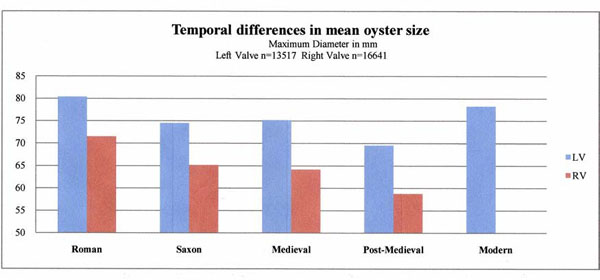
figure 3: Temporal differences in oyster size infestation differences.
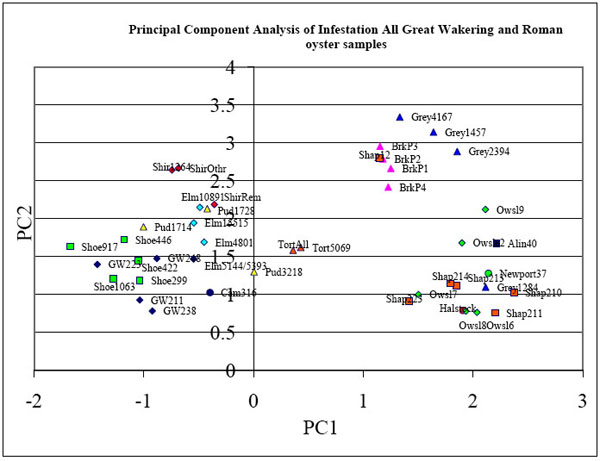
figure 4: Principal Component Analysis of infestation in Roman oysters.
Saxon sites also produce lots of oysters but these are mostly near the coast or with easy access by river to the coast. Deterioration of the roads with the exit of the invaders and poorer organisation meant that oysters could not be sent far. Average size is slightly but significantly smaller than those from Roman sites. To date there is still no evidence for farming or cultivation of oysters.
By the Medieval period, oysters were far more widely distributed across the country. Their size tended not to be the result of selecting less mature specimens but rather a much slower growth rate. This could be attributed to temperature changes but is also likely to be a direct result of oyster relaying and storage activities. Documentary records are made about the ownership of oyster beds and oyster fishing rights. Oysters that are re-laid inter-tidally and periodically exposed at low tides cease to grow whilst out of water. Simultaneously they learn to keep the valves tight shut when exposed to the air. This ability means that they stay alive for longer when traded and dispatched. Improved longevity in keeping fresh means that oysters can be sent greater distances. The greater numbers of oysters found on coastal sites reflects their easy availability and indicates that they were a staple of the diet. The smaller numbers of oysters found at inland sites suggests that the cost of transporting them made them an occasional and luxury item for these people.
Not many oyster specimens of Post-medieval date were made available for study, so conclusions are few. The shells were smaller than in earlier periods.
The Modern period, for current purposes, is taken as including the 19th century onwards. This saw the advent of oystermen and more and more boats went out to fish the beds. Holding pits on the shore became commonplace to store the catches before marketing. Prices of oysters plunged. They became the food of the common people everywhere, not just those living on the coast. They were so cheap that London apprentices complained of their monotonous diet of oysters and salmon.
Eventually, the oyster beds were over-fished and stocks became depleted. Efforts were made to cultivate oysters and breed foreign species. All attempts failed. The final blow to the incredibly successful oyster industry of the 19th and early 20th centuries came with massive extinctions of beds in the 1920s – thought to result from extreme cold weather and disease.
A few natural beds of oysters survived. Oysters became a luxury item on the menu again. A second catastrophe in the form of Bonamia (a protozoan parasite) disease decimated remaining stocks in the 1970s. This time modern technology came to the rescue of the British oyster industry by breeding oyster spat of both O. edulis and Crassostrea gigas in the laboratory so that beds could be restocked. Oyster farming today with its net bags of brood oysters and floating platforms would not be recognised by our predecessors. Their methods were undoubtedly simpler but harder and we still have much to find out about them.
After working on oysters for over 30 years now, I remain as passionate about the subject as ever, fascinated by their variability and what this might mean for the interpretation of archaeological material and our understanding of both the railways and with them a cheap way of selling oysters to the masses all over the country. It was a boom time for human exploitation of this marine resource and of our changing natural environment.
REFERENCES
Bell, A. (1921) British oysters past and present. Essex Naturalist (Stratford). 19, 183-221 and 300-2.
Winder, J.M. (1980) The Marine Mollusca. In Excavation at Melbourne Street, Southampton, 1971-76 (ed. P. Holdsworth), 121-127. Southampton Archaeological Research Committee, Report 1, CBA Report 33.
Winder, J.M. (1987) A report on the marine molluscs from the excavations at 49-53 Moorgate and 72-73 Coleman Street. Unpublished report for the Department of Urban Archaeology, Museum of London.
Winder, J.M. (1993) A study of the variation in oyster shells from archaeological sites and a discussion of oyster exploitation. PhD Thesis, University of Southampton, Department of Archaeology, Faculty of Arts.
Winder J.M. (1997) Oyster and other marine molluscs, in Excavations at Hamwic, Volume 2: excavations at Six Dials edited P. Andrews, Council for British Archaeology Research Report No. 109, 247.
Winder J. M. (2002) Oysters and other marine mollusc shells from Great Wakering, Essex. Report for Essex County Council Field Archaeology Unit.
